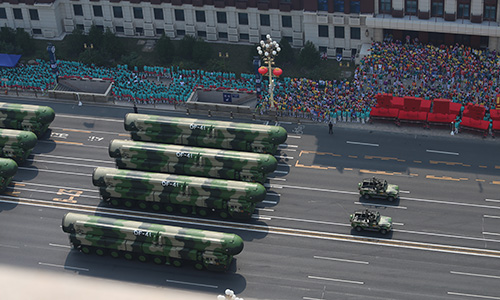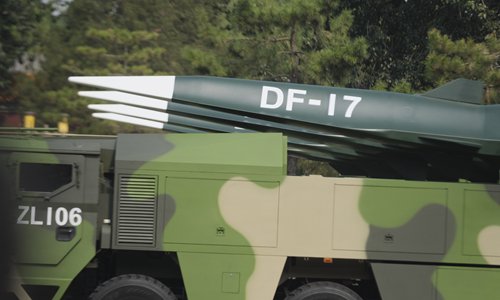HOME >> CHINA,SPECIAL-COVERAGE
China's grand military parade showcases confidence, transparency, stokes patriotism
By Yang Sheng and Cao Siqi Source:Global Times Published: 2019/10/1 17:37:30 Last Updated: 2019/10/3 9:48:59
Massive National Day event sparks patriotism across the country

China reveals its most advanced nuclear-armed intercontinental ballistic missile, the DF-41, at the National Day parade in Beijing on October 1, 2019. Photo: Fan Lingzhi/GT
A grand military parade and a mass pageantry marking the 70th anniversary of the founding of the People's Republic of China (PRC) were held in Beijing on Tuesday that featured the country's most sophisticated weaponry and spectacular performances, while patriotism and pride swelled among Chinese as they celebrated the country's seven decades of achievement under the leadership of the Communist Party of China (CPC).Chinese President Xi Jinping delivered a keynote speech before the military parade on the Tiananmen rostrum.
No force can ever shake the status of China, or stop the Chinese people and nation from marching forward, Xi stressed.
China's yesterday had been inscribed in human history while China's today is being created in the hands of hundreds of millions of Chinese people, Xi said, adding that "China will surely have an even brighter future."
All Party members, armed forces and people of all ethnic groups should unite more closely together, stay true to the founding mission, build on existing achievements and continue to develop our people's republic, Xi said, adding that continued efforts should be made to achieve the two centenary goals and national rejuvenation.
The Chinese People's Liberation Army (PLA) and the People's Armed Police Force should always preserve their nature, purpose and character as the forces of the people, resolutely safeguard China's sovereignty, security, and development interests, and firmly uphold world peace, Xi noted.
After the speech, standing in a black open-roof Red Flag limousine, Xi, also general secretary of the Communist Party of China (CPC) Central Committee and chairman of the Central Military Commission, gave the order to Yi Xiaoguang, commander-in-chief of the military parade, to start the review.
Advanced military weapons from the PLA made their public debut. The scale of the parade was greater than those commemorating the 50th and 60th anniversaries of the PRC founding, including the V-Day military parade in 2015.
Tuesday's parade featured 59 phalanxes, 15,000 people, 168 aircraft, and 580 weapons and military equipment. It was the largest in recent years.

Photo: Zhang Haichao
Confidence and transparencyShowcasing its most advanced intercontinental ballistic missile (ICBM) DF-41, hypersonic ballistic missile DF-17, the latest bomber H-6N with refueling capability, and submarine-launched ballistic missile JL-2, China demonstrated the transparency of its weaponry development and the country's growing confidence in its military strength.
Chinese military experts also noted that the array of advanced weaponry sent a message to hostile foreign forces that China has the ability and confidence to respond to any kind of threat, blackmail or provocation.
"Showing powerful weapons is not intended to scare or threaten any country, but it is like a report to the people that the defense budget was spent the right way because these advanced weapons can effectively deter hostile forces to give up nuclear blackmail against China so that we can keep our country's development from harm," Yang Chengjun, a Chinese expert on missile technology and nuclear strategy and chief scientist of quantum defense, told the Global Times.
According to a white paper titled "China's National Defense in the New Era" released in July, the fundamental goal of China's national defense in the new era is resolutely safeguarding China's sovereignty, security and development interests, and is defensive in nature.
Apart from strategic nuclear power, conventional weapons including the Type 15 tank, Gongji-11 (GJ-11) stealth attack drone, high-altitude high-speed drone WZ-8, and CJ-100 (or DF-100) cruise missile and Z-20 helicopters also made their debut at the parade.
Chinese military experts said this showed a comprehensive development of Chinese military and those forces who intended to challenge China should be aware that China is capable of defeating any enemy when its core interests are threatened.
"Nuclear weapons are unlikely to be used if China doesn't have a serious conflict with other nuclear-armed countries. So conventional weapons are crucial for it to protect its sovereignty and overseas interests," said an anonymous military expert at a Beijing-based military academy.
For enemies like secessionists who intend to separate Taiwan from China, conventional weapons displayed during the parade are totally enough when our country is left with no choice, he said.

A GJ-11 stealth attack drone makes its parade debut during the National Day parade held in Beijing on October 1, 2019. Photo: Fan Lingzhi/GT
'First time'For the first time, the Chinese UN Peacekeeping Force, the PLA Civilian Personnel, PLA military scientists, students of military academies and senior commanders formed square teams at the parade.
About 71 percent of the square team of PLA scientists and military academy students were advanced degree holders, which made the square team the most educated in the parade.
The senior commander team included 352 members from 24 units of the army, ranging in age from 24 to 59. It also included generals, colonels, lieutenant colonels, majors and captains from the PLA Army, Navy, Air Force, and the Rocket Force and armed police forces.
PLA Air Force General Yi Xiaoguang was the parade's commander-in-chief, marking the first time for an Air Force general to lead a National Day military parade.
PLA Air Force Commander Ding Laihang flew a KJ-2000 early warning aircraft over the parade. Although the 2009 National Day parade and 2015 V-day military parade featured senior Air Force officers flying planes, this was the first time an Air Force commander flew by himself during a parade.
Patriotic moment
The military parade followed by a mass pageantry greatly stimulated Chinese people's sense of patriotism. "Excitement, astonishment and wishes" are the three key words seen flooding Chinese social media platforms.
Photos showing the country's most advanced weapons were circulating online, with people from all walks of life amazed by the country's military strength and determination to safeguard world peace. Overwhelming patriotic sentiments were also evident at the parade and the mass pageantry.
A large number of attendees waved the national flag and sang to wish the country a happy birthday. Many attendees told the Global Times that such a close contact with the country's most advanced weapons and equipment made them feel the development and strength of the motherland, which gave them confidence in the country and their own future.
A volunteer for the mass pageantry from the Beijing Forestry University told the Global Times, "I was overwhelmed. I feel proud to contribute to building a strong country."
Another volunteer said even though she started working at 3 am on Tuesday, she felt fulfilled.
"It is a day worth remembering by all Chinese. I would love to stay awake 24 hours, not to mention stay up late," a female attendee told the Global Times. She left home to the site at about 1 am.
Before the parade, two command cars accompanying the president's car when reviewing military troops with license plate numbers "1949" and "2019."
The trailing car, with the license number 1949, the year the PRC was founded, carried no passengers. Many Chinese netizens believe it was a gesture to the country's martyrs and deceased founding leaders.
International perspective
Hujjatullah Zia, a journalist from Afghanistan, watched the military parade and mass pageantry on Tuesday.
"I saw an integration and demonstration of China's military power, technological advancement, and cultural diversity," he said.
He slammed some Western media reports that China wanted to flex its muscles with a military parade.
"It is China's right to celebrate the event, be it through a military parade, as any other country," he told the Global Times.
Zia believed the parade conveys a national and international message: "First, Chinese leaders assured their citizens of security by improving the country's military strength in the last seven decades. Second, Chinese military development suggests its strength in regional and global peacekeeping," he said.
Muhammad Zamir Assadi, a journalist from Independent News Pakistan, was also invited to watch the parade.
For Assadi, the parade "is really a proud moment not only for Chinese but also for the international community."
"The patriotism and enthusiasm of Chinese citizens have impressed me a lot as it shows their commitment to their homeland which pushes them to work for the betterment of society," he told the Global Times.
Assadi said he liked the culture-related performances and presentations which showed that the various ethnic minority groups in China are enjoying their lives, and have their basic rights fulfilled by their motherland.
"The display of upgraded military weapons and arsenal was a message that China is ready to defend its land from any threat and also not a threat to anyone else," he said, adding that he is confident that the future of China is bright.
Fu Guohao, Liu Xuanzun, Guo Yuandan, Leng Shumei and Xie Wenting also contributed to this story
Posted in: SOCIETY,FOCUS 70